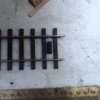ken lawrence
Registered
Hi all.
I'm planning my first 45mm garden railway in North London. It's going to be a tight fit around an already full, mature garden. LGB track on a raised trackbed - and I'm thinking of using 'Filcris' components. Not the cheapest method but it looks interesting. Battery and r/c live steam.
Any experience with 'plastic timber' out there?
Best Regards
I'm planning my first 45mm garden railway in North London. It's going to be a tight fit around an already full, mature garden. LGB track on a raised trackbed - and I'm thinking of using 'Filcris' components. Not the cheapest method but it looks interesting. Battery and r/c live steam.
Any experience with 'plastic timber' out there?
Best Regards


